
Megachile rotundata, the alfalfa leafcutting bee, is a European bee that has been introduced to various regions around the world. As a solitary bee species, it does not build colonies or store honey, but is a very efficient pollinator of alfalfa, carrots, other vegetables, and some fruits. Because of this, farmers often use M. rotundata as a pollination aid by distributing M. rotundata prepupae around their crops. Each female constructs and provisions her own nest, which is built in old trees or log tunnels. Being a leafcutter bee, these nests are lined with cut leaves. These bees feed on pollen and nectar and display sexual dimorphism. This species has been known to bite and sting, but it poses no overall danger unless it is threatened or harmed, and its sting has been described as half as painful as a honey bee's.

Megachilidae is a cosmopolitan family of mostly solitary bees. Both that their pollen-carrying structure is restricted to the ventral surface of the abdomen, and their typically elongated labrum is characteristic of this family. Megachilid genera are most commonly known as mason bees and leafcutter bees, reflecting the materials from which they build their nest cells ; a few collect plant or animal hairs and fibers, and are called carder bees, while others use plant resins in nest construction and are correspondingly called resin bees. All species feed on nectar and pollen, but a few are kleptoparasites, feeding on pollen collected by other megachilid bees. Parasitic species do not possess scopae. The motion of Megachilidae in the reproductive structures of flowers is energetic and swimming-like; this agitation releases large amounts of pollen.
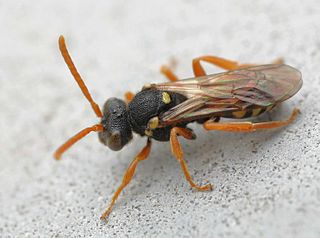
Nomadinae is a subfamily of bees in the family Apidae. They are known commonly as cuckoo bees.
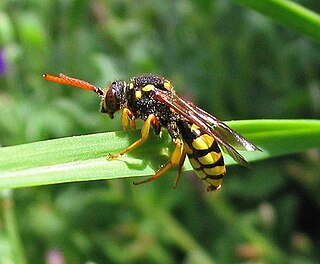
With over 850 species, the genus Nomada is one of the largest genera in the family Apidae, and the largest genus of kleptoparasitic "cuckoo bees." Kleptoparasitic bees are so named because they enter the nests of a host and lay eggs there, stealing resources that the host has already collected. The name "Nomada" is derived from the Greek word nomas, meaning "roaming" or "wandering."

The genus Megachile is a cosmopolitan group of solitary bees, often called leafcutter bees or leafcutting bees; it also includes the called resin bees and mortar bees. While other genera within the family Megachilidae may chew leaves or petals into fragments to build their nests, certain species within Megachile neatly cut pieces of leaves or petals, hence their common name. This is one of the largest genera of bees, with more than 1500 species in over 50 subgenera. The alfalfa leafcutter bee is managed on a commercial scale for crop pollination, and has been introduced by humans to various regions around the world.

Megachile perihirta, commonly known as the Western leafcutting bee, is a bee in the genus Megachile. The bee is native to western North America, ranging from Nebraska to Texas and Mexico, west to California, and north to British Columbia and Alberta, and often inhabits meadows and orchards. The bee is black with long whitish-yellow hair, more so below the thorax and abdomen. The abdomen, however, is mostly bare, although each segment has scattered whitish hair. The wings of the Western leafcutting bee are clear, while their veins are black. The pollen basket below the abdomen is bright red.

Trachusa perdita, the California leafcutting bee, is a species of bee in the family Megachilidae.
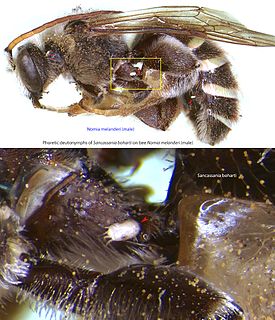
The alkali bee, Nomia melanderi, is a ground-nesting bee native to deserts and semi-arid desert basins of the western United States. It was described by Theodore Dru Alison Cockerell in 1906. While solitary, these bees nest near each other and can form extremely dense aggregations in areas with favorable conditions.

Megachile campanulae, known as the bellflower resin bee, is a species of bee in the family Megachilidae. Described in 1903, these solitary bees are native to eastern North America. Studies in 2013 placed them among the first insect species to use synthetic materials for making nests. They are considered mason bees, which is a common descriptor of bees in several families, including Megachilidae. Within the genus Megachile, frequently also referred to as leafcutter bees, M. campanulae is a member of the subgenus Chelostomoides, which do not construct nests from cut leaves, but rather from plant resins and other materials. Females lay eggs in nests constructed with individual cell compartments for each egg. Once hatched, the eggs progress through larval stages and subsequently will overwinter as pupae. The bees are susceptible to parasitism from several other bee species, which act as brood parasites. They are medium-sized bees and the female adults are typically larger than the males. They are important pollinators of numerous native plant species throughout their range.

Coelioxys, common name leaf-cutting cuckoo bees or sharp-tailed bees , is a genus of solitary kleptoparasitic or brood parasitic bees, belonging to the family Megachilidae.
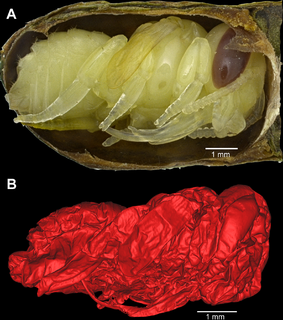
Megachile gentilis is a species of bee in the family Megachilidae. It was described by Cresson in 1872.
Megachile illustris is a species of bee in the family Megachilidae. It was described by T B Mitchell in 1930.

Megachile melanophaea is a species of leaf-cutter bee in the family Megachilidae. It was first described by the British zoologist Frederick Smith in 1853. It is native to North America.

Megachile rubi is a species of leaf cutting bee in the family Megachilidae, found in the eastern United States. First described by Mitchell in 1924, it is placed in the subgenus Xeromegachile, members of which are most often found in sandy areas and have distinct preferences in the petals and leaves they use in their nests.

Megachile texana, the Texas leafcutter bee, is a species of bee in the family Megachilidae. It was first described by the American entomologist Ezra Townsend Cresson in 1878. It is native to the United States and southern Canada.

Megachile maritima, common name coast leaf-cutter, is a species of leaf-cutter bees in the family Megachilidae. It was described by William Kirby in 1802.
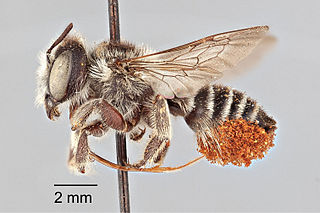
Megachile oenotherae is a species of bee in the family Megachilidae. It was described by Mitchell in 1924.
Megachile umatillensis is a species of bee in the family Megachilidae. It was described by Mitchell in 1927.

The Oriental carpenter bee, Xylocopa nasalis, or Xylocopa (Biluna) nasalis, is a species of carpenter bee. It is widely distributed in Southeast Asian countries. It is a major pollinator within its ecosystem, and is often mistaken for a bumblebee. The species leads a solitary lifestyle with a highly female-biased colony in the nest.

Xylocopa pubescens is a species of large carpenter bee. Females form nests by excavation with their mandibles, often in dead or soft wood. X. pubescens is commonly found in areas extending from India to Northeast and West Africa. It must reside in these warm climates because it requires a minimum ambient temperature of 18 degrees Celsius in order to forage.


















